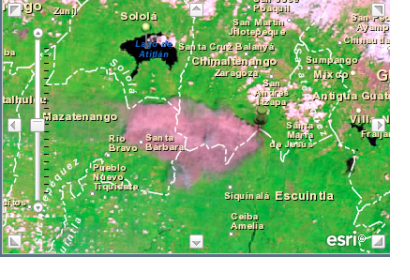UN-SPIDER's Regional Support Office CATHALAC (Water Center for the Humid Tropics of Latin America and the Caribbean) quickly reacted to yesterday's eruption of Guatemala's Fuego Volcano. In the context of SERVIR, the experts published a preliminary analysis of the volcano eruption including NASA MODIS satellite imagery, NOAA GOESS data as well as prognostics on winds and further volcanic activities. Additionally, via CATHALAC's GeoViewer, several pre- and post-disaster images are available tracking the development of the ash cloud. These 14 departments are affected by the ash cloud covering 89,460 hectares of land: Santiago Atitlán, San Lucas Tolimán, Chicacao, Pochuta, Acatenango, Santa Barbara, Patulul, Yepocapa, Alotenango, Rio Bravo, San Juan Bautista, Escuintla, Siquinalá y Santa Lucia Cotzumalguapa.
After the strong eruption of the Fuego volcano on 13 September 2012, Guatemala has evacuated thousands of people after the volcano started spewing ash and lava. Volcanologists said powerful eruptions were catapulting burning rocks as high as 1,000m above the crater and lava was flowing down its slopes. Experts say the eruption of the Fuego, 50km south-west of Guatemala City, is the biggest since 1999.

